
|   |

|   |
 e-mail: leelakaverivenkat@gmail.com Solo projections of high quality and promise in Dance for Dance festival Photos: R Prasanna Venkatesh January 19, 2025 Curated by dancer Malavika Sarukkai, the fifth consecutive Dance for Dance festival (Dec 20-22, 2024) held at the Bharatiya Vidya Bhavan with the co-sponsorship of Kartik Fine Arts, would seem to have carried further, Kalavahini's principle aim of a platform where the best among established dancers, perform in tandem with the specially selected promising young talent. Really deserving dance aspirants struggling against slender resources, will surely benefit from Kalavahini's programme comprising intensity of the Dance Immersion Classes with seed money provided for a new venture - to which is, now, an added heartening introduction of a scholarship. It is a welcome sign when senior dancers who have made the grade, exercising concern for the future of the art form and for preserving an unassailable adherence to quality, step forward to enlist support for genuinely deserving younger talent. 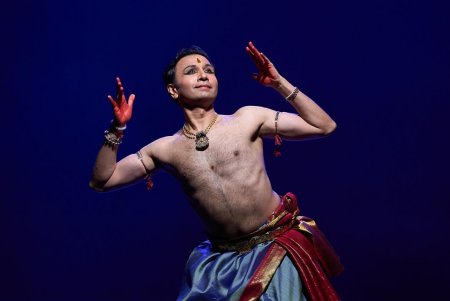 Shijith Nambiar Given its concern for quality, the festival could hardly have had a more evocative start than what was provided by Shijith Nambiar, who is now in a form which one can best describe, as a total immersion of persona in the dance. Very aesthetically conceived, one loved the prologue he gave to his items - for example, delighting in the flowing waters of the Ganges and the grace of the slithering Adu Pambe snake, before centering on the homage to Chitambaranaadar - sporting both on his person - going on to the main item Ananda Natana Prakasham in Kedaram. A lethal combination of stillness and immaculate angasuddha, after another prelude came the presentation of Lalgudi Jayaraman's Varnam in Charukeshi, Innum en manam teriyadavarpol. This centrepiece heralded a dancer with fertile manodharma. The ever flowing improvisational images, conceived round each sahitya line, alongside the whiplash exactitude of teermanams and arudis, by the time of the charanam refrain Kuzhaloodum azhaga Kanna kuraiteera va as a heartfelt call to the fluteplayer to dispel all ills, had catapulted him to a different world. Undoubtedly one of the most involved performances of this highly popular varnam! Shijith was supported by a sensitive team of musicians able to keep up with the dancer's on-the-spot touches with nattuvangam by Udayshankar Lal, Binu Venugopal for vocal support, P.K. Sivaprasad on mridangam, and with Easwar Ramakrishnan on violin, Hariprasad Subramaniam on flute and Rakesh Pazhedam on the ganjira with Nambu Kumar on the lights. The finale was a devotee's call to Muruga, Velava Kanda Shanmukha, smoothly moving to the end with a Tillana flourish ni ri ni ri ga ma garisa in Poorvi. The next dancer Meenakshi Srinivasan began with the heralding of the auspicious birth of Sri Krishna from the Srimad Bhagavatam, with Kinnaras and Gandharvas rejoicing that the destroyer of Asura roopas had arrived on earth. For the varnam, she chose Balamurali Krishna's Omkara Pranava Nadodbhava Sruti laya Swarupa in Shanmukhapriya. The abstraction in a theme like this to be woven into the language of gestures and dance is very difficult. It is a state- of-being and there is little to pin the theme of the stillness of 'Om' into dance language, though the link with Krishna's flute music brings in some clarified images. The nritta punctuations were very neatly executed. The post-varnam interpretative dance saw a less well known padam attributed to Kshetraiyya, showing Krishna in brooding loneliness, longing for his supreme beloved. Yemi teliyudu moha he says, unable to explain this. Performing this with deep involvement, the program totally built on homage to Krishna and his flute, went on to a Tillana by Balamurali Krishna. 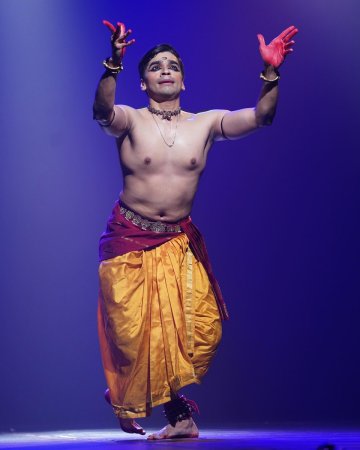 Shobhit Ramesh Kalavahini's scholarship awardee Shobhit Ramesh, gave a performance which most certainly spoke of high talent, with great promise for the future. The recital was totally based on the work of Sri Narayan Guru, who preached- One God, Universal Oneness, One caste, Equality and brotherhood! The recital in all its variations was in search of that secret quality - that Macro oneness - binding all life in this 'prapancham'. What the choreography presented was mentioned as a changed version by Mavin Khoo of what Krishna Rao had earlier conceived. The music inspired by what vocalist T.M. Krishna had rendered of this social reformer's works, carried in its repetitive refrain, a haunting quality, with a quiet power. A very persuasive dancer, Shobhit, however, needs to be more aware of the compulsions of time on the stage and this youngster must learn the art of ruthless editing of all that is not totally essential to convey the theme. 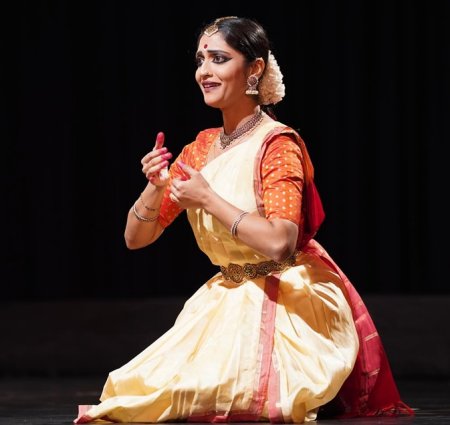 Meenakshi Grama Meenakshi Grama, the other Kalavahini choice for the Senior Fellowship, in her refined presentation of Ashma (Made of Stone), as the daughter of Ahalya, recaptured the anguish and injustice of the punishment meted out to the mother, who, as a young fun loving maiden full of joy and laugher of life, had been married off, without her permission, to a dry rishi - who lost in penance, and abstinence, had dampened all desire in the wife. Ironically, a culture which boasts of works like the Kama Sutra, has evoked the harshest of punishments for women driven by natural sexuality. Tricked by Indra, the mischief maker, young Ahalya succumbing to a moment of temptation was made the sacrificial goat for the rest of her life - till redeemed by Rama. Kitni Nariyan Dhoka Khayengi Bolo Raghukula, is the agonizing cry of the daughter, speaking on behalf of all womanhood. "How many more women will meet a similar fate?" she demands of the Lord. The music and dance were both of a refined quality. Clearly, here is a talent to look out for! 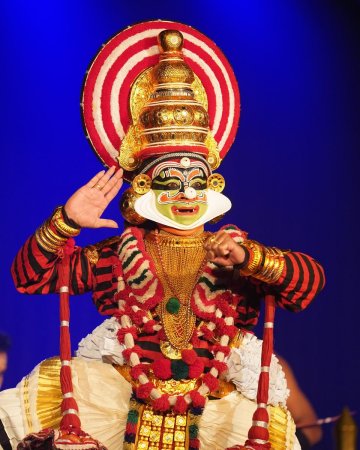 Margi Madhu Chakyar The solo Koodiyattam with Margi Madhu Chakyar's Kailasodharanam and Parvati Viraham from Torana Yuddham, gave an insight into the kind of actor concentration, equal to a penance - so demanding is the complete immersion in what is to be portrayed. Ravana is boastful about having won over the three worlds while Parvati and Shiva are having an altercation. Parvati expresses her annoyance at the presence of Ganga perched on Shiva 's tresses. There is an argument, with Parvati pointing out suspiciously at each feature of Ganga - with the frankly ridiculous answers by Shiva - like her breasts being only Chakravakam birds (!), all part of the hyped language of Koodiyattam! But in this case, only a solo actor Margi Madhu Chakyar as Ravana, takes on all the roles. A single actor taking on multi roles while narrating an episode, or indulging in a throwback to the past or Nirvahanam as it is called, are the main dramatic devices in the enacting of a role in Koodiyattam along with the recitation of the Sanskrit sloka selected in a typical raga, which is unlike any other music. The altercation has a happy end when Parvati, frightened by the way in which Mount Kailash, Shiva's home is being handled by Ravana, runs to the refuge of her husband's arms - and there is a prolonged narration of how Shiva, enraged at the temerity of Ravana in lifting Mount Kailash and playing with it, punishes Ravana. The concentrated intensity of holding each moment for so long in Koodiyattam, is controlled in timing, by the drummer seated at the back on a stool playing on the copper drum the mizhavu, which in a variety of tones provides mood as much mood as tala. In this program, mizhavu was played by Kalamandalam Manikandan with his assistant the second percussionist in Nepathya Jinesh. Edakka was played by Kalamandalam Rajan and on the Kuzhi talam was Dr. G. Indu. A superb performance! The guest invitee in the festival, Apsaras Dance Company of Singapore presented Anuradha - Gopi to Goddess. Radha in her full-blown presence, of course occurs in Jayadeva's Gita Govindam, the love poetry that has enthralled dancers in all Indian dance forms in all parts of India - barring Sattriya dance, which has no character like Radha. The more one goes into the poetry of the Gita Govindam, the more one unravels in coming to grips with the depth of this poetry - and its treatment in dance can be as banal as forming the most exalted statement on the power of sringar. Where else does the God himself express pain at the absence of separation from his mortal beloved, finally declaring his love in the most memorable way, "Twamasi mama bhooshanam, Twamasi mama jeevanam" (You are my adornment, my life's breath and very existence). The couple of lines were strangely left out of this presentation, though the climax when Krishna bowing down in complete submission asks Radha to put her foot on his head - Smara galana khandalam mama shirasi mandalam dehi pada pallavamudaram was included. One is of course entitled to one's own approach and in the Brindavan/Mathura area, Radha is a deified figure - with the expression of greeting being 'Radhe Radhe". While big names like Bombay Jayashri Ramnath as music composer and Rama Vaidyanathan as creative collaborator for Anuradha, raised a lot of expectation, the actual presentation fell woefully short. In the ultimate analysis, it is the dance language that counts. And here, in all earnestness, one would beseech a great deal more of hard, sustained work, before a degree of conviction in presentation is attained. 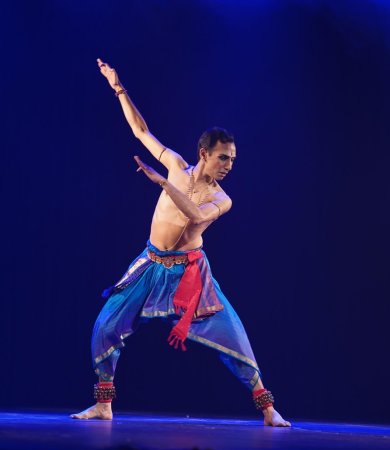 Praveen Kumar The senior fellowship holder for this festival Praveen Kumar, gave an elegant recital, his presentation based on his compositional ideas, penned into script form by scholar Shatavadhani Dr. R Ganesh. The opening was with a production showing Arjuna, in a mood of gratitude reliving the solace and companionship of Krishna, as guide, philosopher and friend. Nimma vatsalya bhavanu nadaside nanna jeevana sapalate padedide - Arjuna in fervent gratitude expresses how Krishna guided and shaped his life through events like Panchali's Swayamvara and how he facilitated Subhadra's elopement with him. When Arjuna, laying down his arms, expressed total unwillingness to fight against persons he had shared his life with on the eve of the Kurukshetra war, his extreme reluctance to fight was overcome by Krishna's sermon on Kshatriya duty. Providing Arjuna a glimpse into his Viswaroopa, he explains what Dharma is all about. Krishna, finally as the charioteer steers Arjuna's fate on the Kurukshetra battlefield. There was a sensitive touch to the gestural choreography, when Arjuna about to embrace Krishna in friendly gush, suddenly realizing his greatness, withdraws his outstretched hands to kneel before the vision that he has been treated to. Questioning the artiste on a dance historian's query about Krishna and Arjuna being portrayed as companions as early as when Arjuna was being initiated into archery, the dancer mentioned that he had, for dance purposes, built on a point mentioned in the Mahabharata, of Krishna and Arjuna's first meeting in the Sandeepana Ashram. The new interpretative item portraying the Nereekshaka Nayaka was built round the non-appearance of the Nayika who had sent her Dooti to specially inform the Nayaka of the time and place of meeting. "Illige baarendu sollisidavalu elli?" (Where is she who asked me to come here?). The inexplicable absence disturbs the Nayaka, who is left wondering. With music in Pahadi, the item was translated into a refined abhinaya statement, leaving behind a lingering image of the wondering, expectant Nayaka. The poetic finale was fashioned round certain features of Nature usually associated in the mind, in a cause and effect relationship. The item rested on Shatavadhani Ganesh's script fashioned round the dancer's suggestions of the subjects - of the sun and lotus, of clouds and the rainbow, and of a creeper and the tree it grows around and clings to for support. A recital of this nature depends on imaginative musical support which in his case was provided by R. Raghuram vocalist and music composer, and Anoor Vinod Shyam who gave nattuvangam support apart from touches on kanjira and tabla. 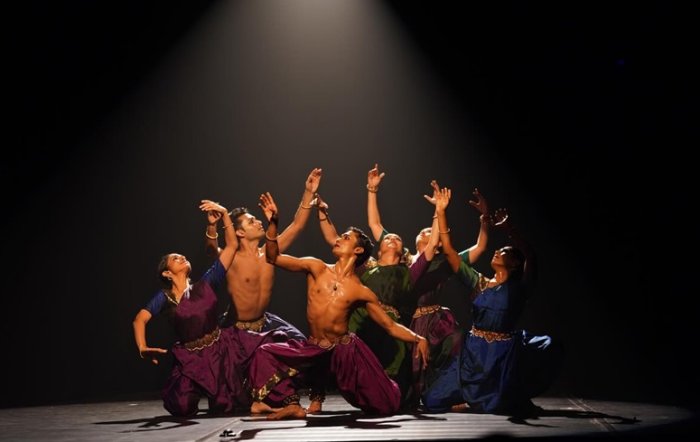 Storm before the calm Rama Vaidyanathan's creation Storm before the Calm made for an end with a bang. It was a kind of choreographic chutzpah, wherein classroom explorations were deemed more viewer worthy than the finished creation - with the churning while trying out steps and combinations becoming the final product. Can the spontaneity of classroom practice rival the calculated aesthetics of a finished product? The dance, while being practiced wanders into alleys - and here, Rama's students from different cities, exhibit a bonhomie and togetherness, quite magical. The unexpected encounters with single dancers coming together, and a play on words - Mam / bhavam / vaibhavam /Yoga vaibhavam /Tyagaraja Yoga Vaibhavam, Sada Shivam. Suddenly two dancers, trying out positions as Nataraja and the snake (naga Bindukala…) begin dancing in relation to each other. The individual going on his independent course gradually merges his identity in the group and the entire space becomes intimate space, and one gets a feel of larger spaces Bhoganda, Moganda, Mukkanda…. Sudha Raghuraman's music voyaging in improvisations is as original as the dance conception. Instruments like the morsing provide special punctuations. Full marks to the entire team! 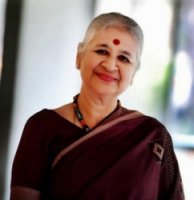 Writing on the dance scene for the last forty years, Leela Venkataraman's incisive comments on performances of all dance forms, participation in dance discussions both in India and abroad, and as a regular contributor to Hindu Friday Review, journals like Sruti and Nartanam, makes her voice respected for its balanced critiquing. She is the author of several books like Indian Classical dance: Tradition in Transition, Classical Dance in India and Indian Classical dance: The Renaissance and Beyond. Post your comments Please provide your name and email id along with your comment. All appropriate comments posted with name and email id in the blog will also be featured in the site. |